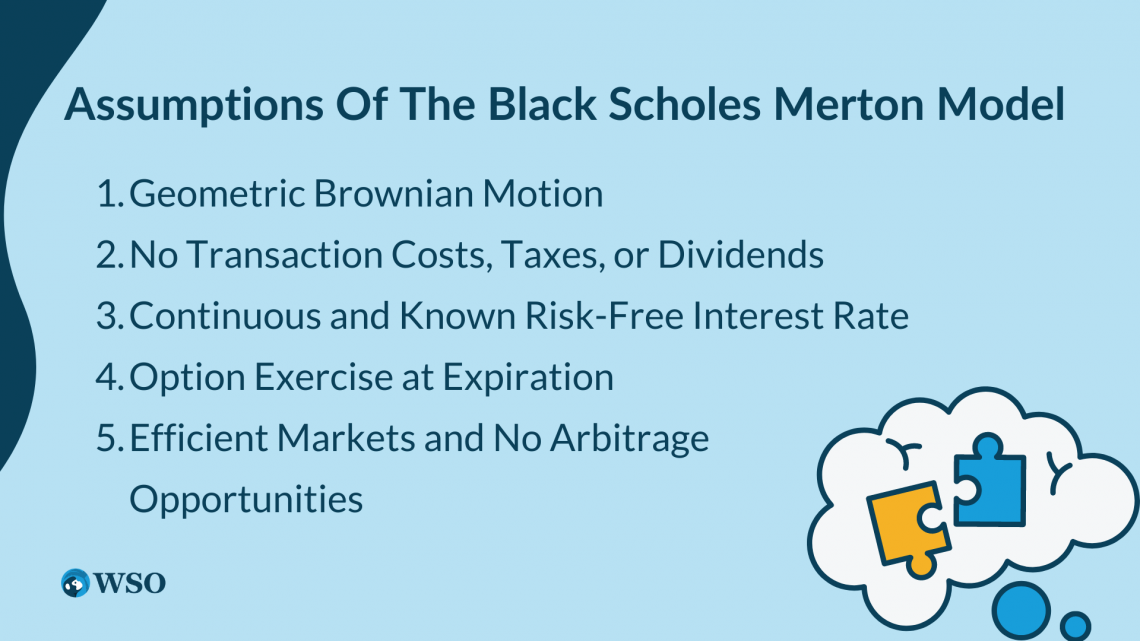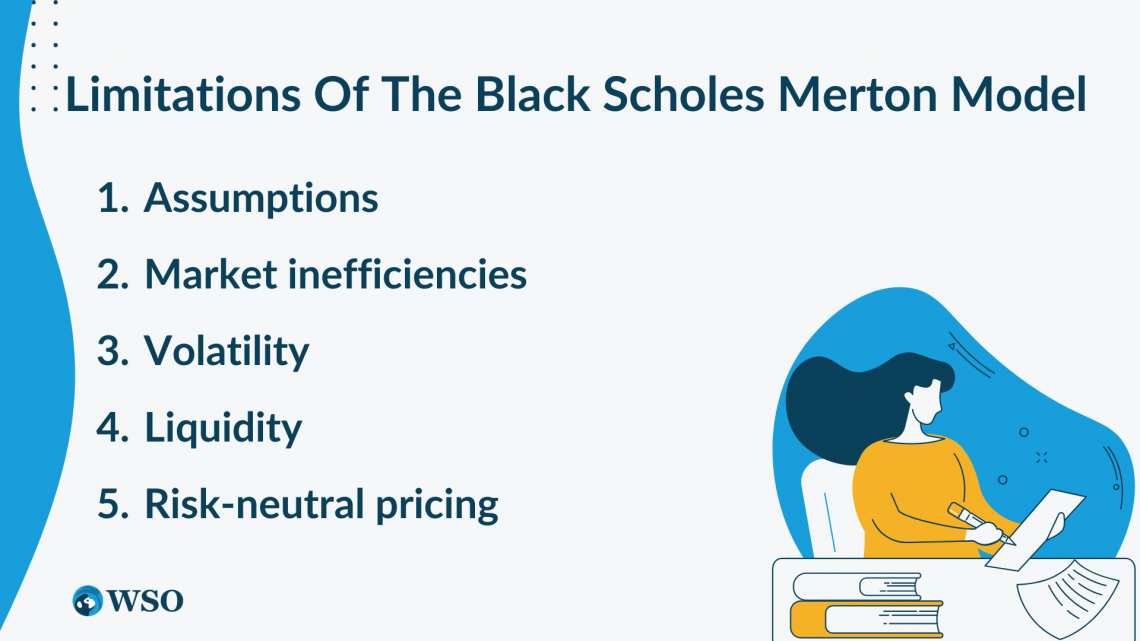Black-Scholes-Merton Model
Renowned mathematical framework used in finance to value European-style call and put options on stocks, indices, and futures
The Black-Scholes-Merton model is a renowned mathematical financial framework to value European-style calls and put options on stocks, indices, and futures.

It was invented by Fischer Black, Myron Scholes, and Robert Merton in the early 1970s. It is widely regarded as one of the most notable contributions to modern finance.
The model assumes that the underlying asset's price follows a geometric Brownian motion and disregards transaction costs, taxes, or dividends on the underlying asset.
Additionally, it assumes that the risk-free interest rate is constant and that the option can only be exercised at expiration. These suppositions are then employed to determine the price of the option based on the following factors:
- The current price of the underlying asset
- The exercise price of the option
- The expiration time
- The volatility of the underlying asset
- The risk-free interest rate
The Black-Scholes-Merton model serves multiple purposes, including valuing options contracts, estimating the underlying asset's volatility, and developing hedging strategies to minimize the risk associated with the option.
The development of the Black-Scholes-Merton model stemmed from the need to accurately value options contracts, which were gaining popularity as tools for hedging and speculating in financial markets.
NOTE
Before this model, options were typically valued using complex mathematical formulas or by trial and error. These methods were frequently inexact and time-consuming, making it difficult for traders and investors to decide about buying and selling contracts.
The Black-Scholes-Merton formula revolutionized the field of finance by providing a simple, intuitive formula for valuing options contracts.
The model's foundations lie in key assumptions about the behavior of financial markets like the underlying asset's price follows a geometric Brownian motion and the absence of transaction costs, taxes, or dividends on the underlying asset.
The model was first published in a series of papers by Black, Scholes, and Merton in 1973 and 1974. The papers received widespread attention and quickly became the standard method for valuing options contracts.

In recognition of their contributions, Black, Scholes, and Merton won the Nobel Memorial Prize in Economic Sciences in 1997.
Since its evolution, the Black-Scholes-Merton process has become a foundation of modern finance and has been applied in various fields (options trading, risk management, and quantitative analysis).
Although the model has limitations and may not always align perfectly with real-world conditions, it remains an essential tool for understanding financial market behavior and valuing options contracts.
Key Takeaways
- The Black Scholes Merton model has become a widely used tool in finance.
- Ongoing efforts are being made to refine and expand upon the model, ensuring its continued relevance.
- The model’s development demonstrates the importance of collaboration between mathematicians, economists, and finance professionals.
- The Black Scholes Merton has some limits, such as the efficiency of the markets.
- The Black-Scholes-Merton method can be employed to develop a wide range of trading strategies, including options trading, volatility trading, and delta hedging.
- The Black-Scholes-Merton formula gives the theoretical price of a derivative, offering insight into its value.
Assumptions of the Black Scholes Merton model
The Black-Scholes-Merton model is built on several key suppositions about the behavior of financial markets. These conjectures are necessary to create a simplified model that can be used to value options and develop hedging strategies.

However, they are idealized and may not accurately reflect the real-world complexities of financial markets. The assumptions are:
1. Geometric Brownian Motion
The model assumes that the underlying asset's value follows a geometric Brownian motion. This signifies that the price of the asset changes randomly over time, similar to the behavior of particles in Brownian motion.
The geometric Brownian motion conjecture is indispensable because it allows the model to account for the underlying asset's volatility, which is a key factor in determining the price of a derivative.
2. No Transaction Costs, Taxes, or Dividends
The model assumes no transaction costs, taxes, or dividends on the underlying asset, simplifying the model.
While this presumption may not be true in practice, it is often a reasonable approximation for liquid and actively traded assets.
3. Continuous and Known Risk-Free Interest Rate
The model assumes that the risk-free interest rate is continuous and known. This hypothesis allows the model to account for the time value of money and the opportunity cost of investing in a derivative. However, it also presupposes that there is a risk-free asset that investors can invest in.

4. Option Exercise at Expiration
The model assumes that the option can only be exercised at expiration. This means that the option holder cannot exercise the option early and must wait until the expiration date to exercise it.
This conjecture may only sometimes hold in practice, but it is a reasonable approximation for European-style options.
5. Efficient Markets and No Arbitrage Opportunities
The model assumes that the markets are efficient and have no arbitrage opportunities. This denotes that there are no riskless benefits to be made by trading contracts and that the price of an option accurately represents the asset's underlying value.
While the efficient market hypothesis is a controversial assumption, it is an important part of the Black-Scholes-Merton model. It helps to ensure that the model produces accurate valuations of options contracts.
Derivation of the Black Scholes Merton model
The Black-Scholes-Merton model is derived using stochastic calculus, a branch of mathematics that deals with random variables and their evolution over time.

The key insight behind the model is that the price of an option can be replicated by a portfolio of the underlying asset and a risk-free asset. Furthermore, this replicating portfolio is constructed to have the same payoffs as the option at all possible future prices of the underlying asset.
The first step in deriving the Black-Scholes-Merton method is constructing the stochastic differential equation that describes the underlying asset's price.
This is done by assuming that the asset's price follows a geometric Brownian motion and using Ito's lemma to derive the evolution of the asset's price over time.
The SDE for the underlying asset is then used to derive the SDE for the option's price, considering the option's payoff function and the replicating portfolio.
NOTE
SDE is the abbreviation of "Stochastic Differential Equation.”
The second step involves solving the SDE for the option's price using the no-arbitrage principle. According to this principle, the price of an option must be equal to the expected value of its future payoffs, discounted to its present value using the risk-free interest rate.
By solving the SDE for the option's price and applying the principle of no-arbitrage, the Black-Scholes-Merton formula is obtained. The formula provides the theoretical price of a derivative as a function of:
- Current price of the underlying asset
- The strike price of the derivative
- Time to expiration
- Risk-free interest rate
- The volatility of the underlying asset
The formula has become widely used in the financial industry for valuing contracts and developing trading strategies. It remains an important tool for understanding the behavior of financial markets and managing financial risk.
Applications of the model
The Black-Scholes-Merton model owns innumerable applications in finance, ranging from valuing options contracts to developing hedging strategies and managing risk. Some of the key applications of the model include:

1. Option pricing
The Black-Scholes-Merton formula is widely manipulated to value options contracts, which give the holder the right to trade an underlying asset at a predetermined price and date.
It authorizes traders and stockholders to determine the just price of a derivative according to the parameters such as the underlying asset's current price, strike price, time to expiration, risk-free interest rate, and volatility of the underlying asset.
2. Hedging
The Black-Scholes-Merton model can be employed to design hedging strategies that minimize the risk of losses in case the value of the underlying asset changes.
Traders and stockholders can protect themselves against changes in the price and ensure that they receive the same payoffs as the option at all possible future prices if they construct a portfolio of the underlying asset and a risk-free asset that replicates the payoffs of the option.
3. Risk management
The model is implemented extensively in risk management, particularly in portfolio management.
Stockholders can assess the risk of their portfolios and adjust their holdings accordingly if they compute the underlying asset's implied volatility. This permits them to manage their exposure to market risk.
4. Trading strategies
The model can be implemented to develop a wide range of trading strategies (options trading, volatility trading, delta hedging, etc.).

By calculating the value of an option at different prices of the underlying asset, traders can identify trading opportunities and make informed decisions about when to buy or sell options.
5. Academic research
The formula has been the topic of academic research and has contributed to the evolution of modern financial theory.
It has been used to analyze the repercussions of market volatility on option prices, the efficiency of financial markets, and the pricing of complex financial instruments such as exotic options. The Black-Scholes-Merton process has had a profound impact on the field of finance and has become an essential tool.
Limitations of the Black Scholes Merton model
The Black-Scholes-Merton model has proven to be a useful tool for pricing options and managing risk, but it is important to acknowledge its restrictions. Some of the key limitations include:

1. Assumptions
The Black-Scholes-Merton model is established on several simplifying hypotheses, such as constant volatility, continuous trading, and no transaction costs. Unfortunately, these suppositions don't precisely reflect real-world financial markets' complexities and can lead to inaccurate predictions.
2. Market inefficiencies
The Black-Scholes-Merton method presumes that markets are efficient and that prices reflect all available information. Unfortunately, markets are not efficient, and various factors, including investor sentiment, market news, and geopolitical events, can modify prices.
3. Volatility
The model assumes that volatility is constant over time. In reality, volatility can change rapidly, especially during market turbulence or uncertainty. Failing to account for changing volatility levels can affect option pricing and risk management accuracy.
4. Liquidity
The model assumes that assets are always liquid and that there are no restrictions on trading.
NOTE
Some assets may be illiquid or difficult to trade, particularly during market stress or crisis.
5. Risk-neutral pricing
The Black-Scholes-Merton model assumes that investors are risk-neutral and don't require a premium for bearing risk. However, stockholders are risk-averse and may require a premium for bearing risk.
Limitations of the Black-Scholes-Merton model underscore its impact as part of a broader financial analysis and risk management framework.









or Want to Sign up with your social account?